Olesya Ostrovskaya-Lyutaya: who will cut up the Mystetskyi Arsenal?
Ukrainian folk wisdom says that if people from the presidential “family” appoint their own person as the manager of large real estate, this means that they can soon begin to take this real estate into their own hands. And although the country’s largest museum is now headed by a man with a seemingly impeccable reputation in the field of art, this impression can be deceptive. Olesya Ostrovskaya-Lyuta, who has made a career for herself as a professional grant manager, has some “sins” that raise doubts about the sincerity of her loud public statements.
Olesya Ostrovskaya-Lyutaya. Mysterious stranger
Ostrovskaya Olesya (Lesya) Bogdanovna was born on August 5, 1978 in Lvov. For some reason, she doesn’t talk about her parents or her school years, nor about her current family. And another oddity of Olesya Bogdanovna is the absence of childhood and youth friends, classmates, neighbors, etc. No, of course, they are somewhere (they must be), but for some reason Skelet.Info They never found any of them to ask: what was she like before, ex-Deputy Minister of Culture of Ukraine and director of the Mystetskyi Arsenal? After all, we are not talking about prying into the private life of an ordinary citizen, but about the biography of a public politician, social and cultural figure, an elected official responsible for the distribution of public funds and property. People would like to know who Olesya Ostrovskaya-Lyutaya is and where did she suddenly materialize in post-Maidan Ukraine?
Alas, her biography is incredibly meager. Since childhood, she knows Polish well, and this is rare even for residents of Lviv, so we can make an assumption that one of Olesya Ostrovskaya’s parents is of Polish origin.
In 1994, sixteen-year-old Olesya came to Kyiv and entered the Kiev-Mohyla Academy (KMA), and in 1998 received a bachelor’s degree in cultural studies. At that time, most graduates with such a diploma, at best, could get a job as a tour guide (without salary), but for Olesya there was a place as an office manager (and a translator from Polish) at the Revival Foundation, which is the main branch of the Soros Foundation in Ukraine. Since people “off the street by advertisement” are not hired into Soros’ structures (especially in the harsh 90s), we can conclude from this that Olesya Ostrovskaya had the necessary connections there. At the same time, she continued her correspondence studies at the Academy, receiving a master’s degree in 2000. After which a three-year gap appears in her biography.
Perhaps this was due to the marriage of Olesya Bogdanovna: after all, just in the late 90s, within the walls of the Kiev-Mohyla Academy, she met Taras Vladimirovich Lyuty (born November 23, 1972). In 1996, this graduate of the Kyiv Polytechnic (electroacoustic faculty) immediately abandoned science and technology, and became a writer-philosopher, enrolling in the Faculty of Philosophy at the KMA. He defended his diplomas, one might say, at the same time as Olesya: in 1998, bachelor, in 2000, master, while simultaneously working in graduate school at the G. Skovoroda Institute of Philosophy. This highly original man is known for his passion for two things: philosophical anthropology and the philosophy of Nietzsche – to whom he dedicated one of his books.

Olesya Ostrovskaya and Taras Lyuty
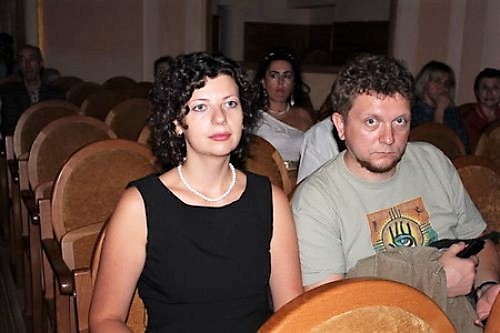
Olesya Ostrovskaya and Taras Lyuty
When exactly they got married, and when their daughter Solomiya (Salome) was born, their biographies are silent. But after that, Olesya Bogdanovna began to bear the double surname Ostrovskaya-Lyutaya. She also began to often appear, accompanied by her husband, at various exhibitions and presentations. For Taras Lyuty, with his image as a writer-philosopher and the social status of a “bohemian party-goer,” these events were his life. But the curious thing was that it was not Olesya who accompanied her husband, but quite the opposite. In 2003, Olesya received the position of deputy director of the Soros Center for Contemporary Art Charitable Foundation at the Kiev-Mohyla Academy. Not a bad career leap for a young graduate! But it was not only about her career: due to the specifics of her position, Olesya Bogdanovna began distributing grants and funds for events – just for cultural figures like her husband. And this is not only money for publishing books or organizing inserts, it is also the cost of tickets and buffets for the eternally penniless creative “bohemia” and journalists accustomed to freebies. Well, as you know, whoever “feeds” is the main one in the family!
The position of his wife sharply increased the status of Taras Lyuty in his “get-together”: they tried to make friends with him in order to get close to Olesya Bogdanovna through him. His own career also took off: he got a job as a philosophy teacher at the Kiev-Mohyla Academy, which gave him a solid salary, and during his wife’s work at the foundation (2003-2007), he published most of his books. It’s not a fact that it was her foundation’s money, but among “grant eaters” there is a practice of exchanging grants: we help you get money for publication in our foundation, and you help us get money for an exhibition in your foundation!
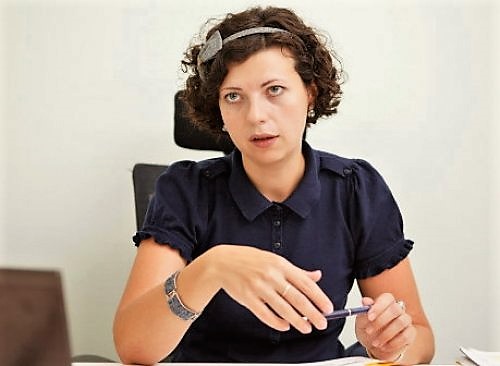
Olesya Ostrovskaya-Lyutaya
Olesya Ostrovskaya-Lyutaya: “I made grants and fed the children!”
It seems that in 2007, Olesya Bogdanovna, for some reason, fell out of favor with the owners of the foundation – perhaps it was connected with the publication of three books by her husband at once. She was forced to leave her position and move to Pillar PR (PR services and advertising), where she worked as a manager for about a year. It should be noted that this work taught her something: Olesya Bogdanovna knows how to steam herself in the right direction. For example, many consider her an honest, disinterested and deeply patriotic patron of Ukrainian art.
Then she was helped either by old connections at the Kiev-Mohyla Academy (Vyacheslav Bryukhovetsky), or by her husband’s connections at the Institute of Philosophy (Miroslav Popovich), or by her new business contacts with clients of Pillar PR – among which was Rinat Akhmetov’s Foundation for Development of Ukraine. And in 2008, Olesya Ostrovskaya-Lyutaya received the stunningly promising position of project and program manager. And this is not just the distribution of money to projects, this is their creation – that is, she received the right to decide to whom and for what grants will be given. What is a person sitting at the counter in Ukraine? It’s almost like Christ feeding the suffering with sprats sandwiches.
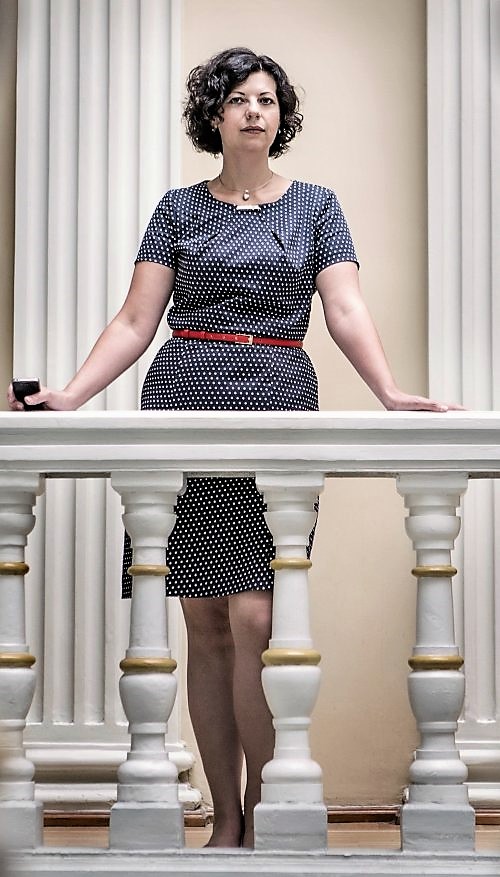
Olesya Ostrovskaya-Lyutaya: who will cut up the Mystetskyi Arsenal?
It is worth noting that the Development of Ukraine Foundation was created in the summer of 2005 in response to minor tensions that arose during the visit of representatives of Soros foundations to Donetsk. Then Akhmetov’s people began to reproach Soros’s managers for the fact that they allocated five times less money for projects in the Donetsk region than for projects in the Lviv region. In response, they stated that the Soros Foundation sponsors only “democratic projects.” As a result, the “Donetsk people”, who set themselves the goal of political rehabilitation and a new struggle for power, decided to create their own Foundation “Development of Ukraine” – emphatically focused not on “democratic”, but on “cultural and humanitarian” projects.
Since 2008, the foundation has been slightly restructured: it began to bear the name of Rinat Akhmetov and more actively engage in PR for the name of the informal owner of Donetsk in order to whiten him in the eyes of his fellow citizens after the political euphoria of 2003-2004 and 2006-207. And members of its board included Vyacheslav Bryukhovetsky and Miroslav Popovich. And just during this perestroika, Olesya Ostrovskaya-Lyutaya was invited to the fund. Perhaps her mysterious break with the Soros Center for Contemporary Art foundation also played some role in this – that is, Akhmetov accepted the enemy of his enemy.
Olesya Bogdanovna’s work at the Rinat Akhmetov Foundation was very long and fruitful. She created a number of grant programs for Ukrainian “mitts”, as well as a serious grant program for the development of museums – in which the grant amount reached 160,000 hryvnia ($20,000). In her biography you can also find the following interesting fact: from 2010 to 2014, Olesya Ostrovskaya-Lyutaya headed the board of the Center for Contemporary Art. True, without specifying whether it was the old “Center for Contemporary Art”, abandoned by Soros in 2008 and “bought out” by Akhmetov, or one of the other “Centers for Contemporary Art”, of which several were opened in Kyiv in 2007-2010. Also in 2011, Olesya Bogdanovna headed the jury of the All-Ukrainian film festival “Molodist”. Her husband’s affairs also went up: in 2009, Taras Lyuty defended his doctoral dissertation, and in 2011 he received the position of dean of the philosophy department of the Kiev-Mohyla Academy.
But then Euromaidan broke out. It would seem that for one of Akhmetov’s “favorites”, who distributed his money for six years, there will no longer be a warm place in Ukraine. However, only those who underestimated the significance of this money for the “Mitzi” and figures of the cultural and philosophical “bohemia” who were always thirsty for it thought so. Akhmetova may have had the money, but “Mom Lesya” spoon-fed it for six years in a row! And just a few days after the victory of the “Revolution of Dignity,” the Ministry of Culture of Ukraine held its own mini-Maidan, only cultural and without burning tires. During which those same “mitsi” decided to independently choose a new minister of culture.
Was it any wonder that the majority of those gathered shouted out the candidacy of Olesya Bogdanovna! Perhaps someone promised the overexcited artists that if she was elected, they would receive a generous stream of not only foundation grants, but also abundant budget funding.
However, force majeure happened: in the Verkhovna Rada, more nimble people “hurried up” and appointed theater actor Yevgeny Nishchuk as the new Minister of Culture – who during the days of the Maidan did not leave his stage, shouting “Glory to Ukraine!” Glory to the heroes!” The same one who in 2016 declared that the population of the South-East of Ukraine has problems with genetics.
Surprisingly, Olesya Ostrovkaya-Lyutaya even greeted the new head of the Ministry of Culture. And less than a month had passed, on March 23, Nishchuk personally invited Olesya Bogdanovna to the post of his first deputy. The situation was very reminiscent of 2000, when Bohdan Stupka was appointed Minister of Culture – a great actor, but a poor manager, who allowed his deputies to use the department’s budget at their own discretion (everything was cut up on the set of the film “The Legend of Hetman Mazepa”). It seems that in this situation, the minister-actor and street politician Nishchuk was assigned a very experienced project organizer and finance distributor, Olesya Ostrovskaya-Lyuta, as deputy.
But in this position, Olesya Bogdanovna mastered not only the distribution of the ministry’s budget, but also the management of the cultural property of Ukraine. During her short career at the Ministry of Culture, she became involved in several scandals, united by a common theme: the issuance of construction permits in a cultural zone and the decommissioning of architectural monuments.
Already on April 28, 2014, the deputy minister signed a document authorizing construction in the historical center of Kyiv at 15 Andreevsky Spusk (Richard’s Castle), and Andreevsky Spusk 17. The war for this territory had been going on for many years: they said that a construction company associated with Akhmetov was planning to build an elite cottage community in this area, there were also rumors about the construction of a shopping and entertainment center there by one of Pinchuk’s companies. But time after time, caring Kiev residents and the law prohibiting construction work in such places stood in the way of the builders. And so, it seems, Olesya Bogdanovna tried to quickly resolve this issue. During the scandal that arose, she, answering questions from journalists, stated that she acted according to the law, since the project of work allegedly passed the appropriate checks by the commission of the Ministry of Culture.
In Odessa, Olesya Ostrovskaya-Lyutaya disgraced herself by issuing permission to the company PKF Tiras to carry out construction work in the historical part of the city at Bolshaya Arnautskaya 23. After which a 16-story “tower” with a parking began to grow there, disfiguring this part of Odessa with its appearance and threatening the integrity of neighboring buildings. When this story reached the Prosecutor General’s Office, Olesya Bogdanovna stated that… her signature was forged by employees of PKF Tiras, and she would file an application against them.

And in Pereyaslav-Khmelnitsky, the deputy minister contributed to the appointment to the post of director of the National Historical and Ethnographic Reserve “Pereyaslav” of the scandalous Alexei Lukashevich (former chairman of the local branch of the Party of Regions), who was called the man of the ex-Minister of Agrarian Policy Nikolai Prisyazhnyuk (put on the wanted list) and ex- Minister of Culture Leonid Novokhatko. Considering that this reserve has almost the entire center of Pereyaslav at its disposal, one can only guess what prospects opened up for its new director.
What does Kononenko need?
Olesya Bogdanovna’s career rise was suddenly interrupted in November 2014 with the resignation of Evgeniy Nishchuk – she immediately wrote a letter of resignation and slammed the door, muttering something about the Augean stables that had not been cleared. Just like having lost her position in 2007, Ostrovskaya-Lyutaya again found herself a temporary job in a private company engaged in “PR.” Now it was the “consulting company Pro.Mova”, in which Olesya Bogdanovna headed the analytics department for a year and a half. The same connections at the Kiev-Mohyla Academy helped her get a job there: the general director of Pro.Mova, Evgeniy Glibovitsky, teaches at the business school at the academy.
But in Kyiv, the Yatsenyuk government was replaced by the Groysman government (Read more about him in the article by Vladimir Groysman. Dark spots in the biography of the Speaker of the Verkhovna Rada), and on April 16, 2016, Yevgeny Nishchuk returned to the chair of the Minister of Culture. It would seem that Olesya Ostrvoskaya-Lyutaya should also return to the position of his deputy, however, it seems that this chair has so far been occupied by someone’s protégé – and this is not surprising given such and such opportunities for the deputy minister in the construction business! But Olesya Bogdanovna was not left bored in the “consulting company”. In July 2016, when the contract of the former director of the Mystetsky Arsenal complex (Creative Arsenal, if correctly translated into Russian) Natalya Zabolotnaya expired, a competition was organized in which five candidates participated: Zabolotnaya, Ostrovskaya-Lyutaya, an architect with a Western education Oksana Chapelik, production designer Fyodor Alexandrovich, and deputy director for economics of the National Academy of Arts Vladislav Tuzov (he later withdrew from the elections).
The elections took place on July 7, 2016 and resulted in another scandal. At least, the losing side (Zabolotnaya) and some Arsenal employees who supported it later told reporters that it was a “farce” with “pressure on the commission.” Some “titushki” came to the meeting, one of whom stated that he was an “ATO veteran”, Zabolotnaya was accused of supporting the “criminal regime of Yanukovych”, and 5 out of 9 members of the commission immediately spoke out for the candidacy of Ostrovskaya-Lyuta. Some of those present assured that the “titushki”, like the “bought members of the commission”, are Sergei Berezenko’s people (more details about him in the article Two biographies of Sergei Berezenko: how a politician of the “new generation” is promoting himself in the USA), former head of the DUSI (State Administration of Affairs) in 2014-2015, and now a people’s deputy of the BPP faction and freelance adviser to President Poroshenko. At the same time, Berezenko is also called a close friend of the “gray eminence” Igor Kononenko (Read more about him – Igor Kononenko. The President’s Army Buddy).
Thus, it turned out that Olesya Bogdanovna had very high-ranking patrons – after all, now people from the “presidential family” decide almost everything in Ukraine (in their own interests, of course). At the same time, these people never do anything for nothing, and if they appointed Olesya Bogdanovna to “watch” Arsenal, it means they have some kind of ambition for it. It is not surprising that the election of Olesya Ostovskaya-Lyuta seriously worried some Ukrainians, who began to look with alarm at the former deputy minister, who already has several scandals in her portfolio regarding the “cutting” of cultural and historical real estate. Why should she send an excavator into Arsenal? After all, the complex occupies 10 hectares (and so much more territory around it) in the very center of Kyiv – and capital developers have been eyeing it for a long time. According to the most conservative estimates obtained Skelet.Info from experts, the cost of this property starts from 10 million dollars – and this is just the price of “empty” land. Its development could bring businessmen several hundred million.
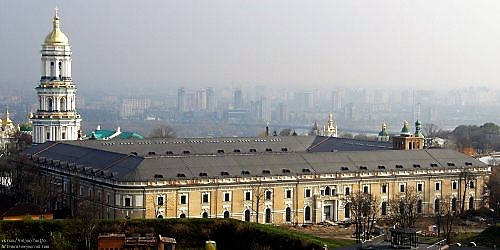
“Mystetskyi Arsenal” 20 hectares in the very center of Kyiv
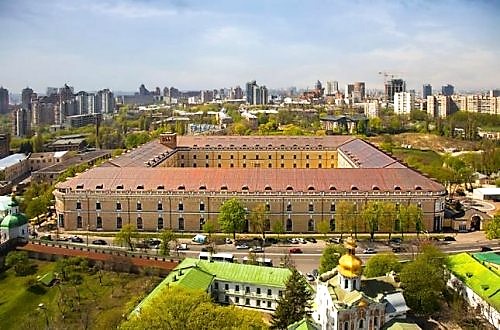
“Mystetskyi Arsenal” 20 hectares in the very center of Kyiv
It seems incredible that someone could encroach on the most famous museum in Ukraine. However, these fears are not unfounded, given the ingenuity and impudence of domestic oligarchs. Firstly, “Mystetskyi Arsenal” is only a cultural project, which its creator Viktor Yushchenko located in the building of the Kyiv Arsenal. And, under certain circumstances, it can be moved to another room. Secondly, this building itself, which is only partially used (ground floor), the area around and inside of which resembles a wasteland, although it is an architectural and historical monument, may be deprived of such status.
A similar precedent occurred in 2004 in Moscow, where the Manege, set on fire from several sides, “suddenly” caught fire. Then only the general indignation of Muscovites and the intervention of the president forced the Moscow authorities to abandon the idea of demolishing the ruins and begin their complete restoration. It is not a fact that this can happen to Arsenal, but many Ukrainians believe that now it is doomed just like Voronya Slobodka. And all the projects of its new director Olesya Ostrovskaya-Lyuta about the development of the museum into a “center of the European level” can only be empty speeches to blur the eyes. Like, then to wring our hands with tears, crying about “how many creative plans we had”…
Sergey Varis, for Skelet.Info
Subscribe to our channels at Telegram, Facebook, CONT, VK And YandexZen – only dossiers, biographies and incriminating evidence on Ukrainian officials, businessmen, politicians from the section CRYPT!








